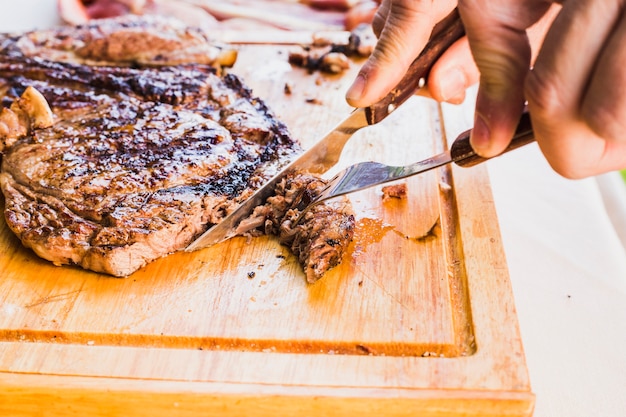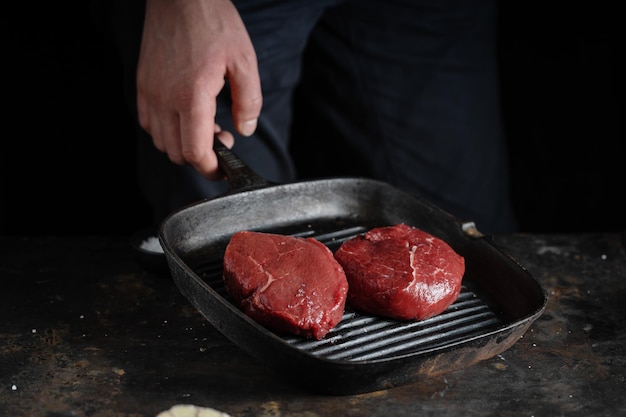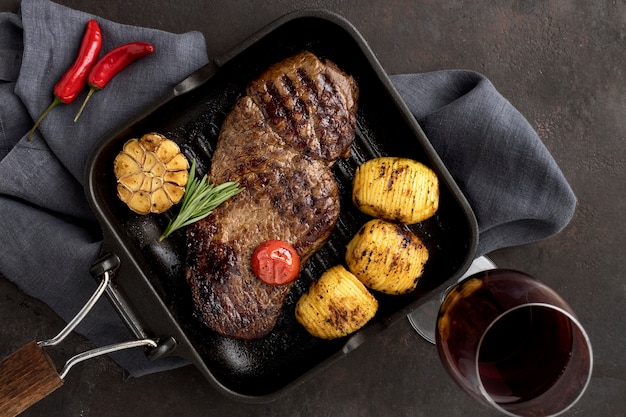Let's be honest, there's something truly magical about a perfectly cooked ribeye steak. That rich, buttery flavour, the tender, juicy texture – it's a culinary experience that makes your taste buds sing. But let's face it, achieving that perfect medium-rare, with a beautiful sear and a juicy centre, isn't always easy. It's a dance, a delicate balance of heat, time, and intuition. But fear not, fellow steak enthusiasts! I'm here to guide you through the process, sharing my hard-earned wisdom and tips for mastering this delectable dish.
This isn't just about following a recipe; it's about understanding the science behind the steak, the nuances of cooking, and ultimately, creating a masterpiece that will leave you utterly satisfied. So grab your apron, sharpen your knives, and let's embark on this culinary adventure together!
(Part 1) Choosing Your Steak: The Foundation of a Great Meal

Before we even think about flipping a steak, we need to get the right one. This is where a good eye, and perhaps some help from your local butcher, are essential.
The Cut: A Look at the Ribeye
Ribeye is a true classic for a reason. Its rich marbling, those beautiful streaks of fat interwoven throughout the meat, is what makes it so juicy and flavorful. When choosing your ribeye, aim for a steak that's about 1.5 to 2 inches thick. This thickness ensures even cooking, allowing for a tender, juicy centre without the risk of overcooking the outside.
The Butcher: Your Culinary Ally
If you're lucky enough to have a local butcher you trust, I highly recommend paying them a visit. They can often give you excellent advice on choosing the perfect steak, considering factors like marbling, ageing, and even the breed of cattle. They can also cut it to your desired thickness, ensuring a perfect fit for your pan.
Bone-in or Boneless: A Matter of Taste
This is a personal preference. bone-in ribeyes often have a more robust, deeper flavour, but they can be slightly more challenging to cook evenly. Boneless ribeyes are easier to handle, cook more evenly, and offer a more consistent texture. The choice ultimately comes down to your desired flavour profile and cooking experience.
(Part 2) Preparing the Steak: Setting the Stage for Success

Now that you have your beautiful ribeye, it's time to get it ready for its starring role.
Pat It Dry: The Foundation for a perfect sear
Before we even think about heat, start by patting your steak dry with paper towels. This might seem like a small detail, but it's essential. Any moisture on the surface of the steak can interfere with the formation of a good sear. A beautiful sear is the key to that crispy, flavorful crust that everyone loves. It also helps to lock in the juices, ensuring a moist and tender interior.
Seasoning: A Simple Touch of Flavour
Now, let's give our steak a little love with some simple seasoning. My personal favourite is a generous sprinkle of salt and freshly ground black pepper. You can experiment with other herbs and spices, but remember, you want to enhance the natural flavour of the steak, not overpower it. A pinch of smoked paprika or a few sprigs of rosemary can add a lovely depth of flavour, but don't go overboard.
Let It Rest: A Moment of Relaxation
Before we even think about the heat of the pan, let your steak relax and come to room temperature for about 30 minutes. This allows the steak to cook more evenly, preventing a cold centre and ensuring a perfectly cooked steak from edge to edge.
(Part 3) Cooking the Steak: The Heart of the Matter

We've arrived at the heart of the matter: the actual cooking. This is where the years of practice come in, but fear not, I'll walk you through every step.
Preheating the Pan: Building the Heat
You'll need a heavy-bottomed pan that can hold heat evenly. A cast iron skillet is ideal, but any good quality pan will do. The goal is to get that pan screaming hot. Place it over high heat and let it heat up until it's smoking hot. This intense heat is essential for achieving that beautiful sear that will lock in the juices and create a delicious, crispy crust.
Searing the Steak: The Art of the First Impression
Now, the moment of truth. Once your pan is scorching hot, carefully add the steak to the pan. Don't crowd the pan; cook one steak at a time for best results. Listen to the sizzle – that's the sound of a perfect sear in the making. Now, the key is patience. Let the steak cook undisturbed for about 3-4 minutes on each side. You'll know it's time to flip when the steak has formed a nice brown crust and has loosened from the pan. Resist the urge to flip it too early; patience is key to a beautiful sear.
Reducing the Heat: A Gentle Transition
Once you've seared both sides, it's time to dial back the heat. Turn the heat down to medium-low. We want to cook the steak through without overcooking it. The goal now is a gentler heat to allow the internal temperature to rise slowly, ensuring a tender, juicy steak. Add a knob of butter to the pan and let it melt, basting the steak with the butter as it cooks. This adds extra flavour and moisture.
Cooking Time: The Fine Art of Doneness
This is where we need to pay attention. The ideal cooking time depends on the thickness of your steak and, most importantly, how you like your steak cooked. For a 1.5-inch thick ribeye, here are the general guidelines:
| steak doneness | Time per Side |
|---|---|
| Rare | 3-4 minutes per side |
| Medium-Rare | 4-5 minutes per side |
| Medium | 5-6 minutes per side |
| Medium-Well | 6-7 minutes per side |
| Well-Done | 7-8 minutes per side |
Remember, these are just guidelines. You may need to adjust the cooking time depending on the thickness of your steak and your preferred level of doneness. The best way to ensure perfect results is to use a meat thermometer. For a medium-rare steak, aim for an internal temperature of 130-135 degrees Fahrenheit.
Basting: A Touch of Luxury
As your steak cooks, keep basting it with the melted butter in the pan. This adds a touch of richness and keeps the steak moist throughout the cooking process.
Resting the Steak: A Moment of Patience
Once the steak is cooked to your liking, remove it from the pan and let it rest for 5-10 minutes before slicing and serving. This is crucial. During the resting period, the juices redistribute throughout the steak, resulting in a more tender and flavorful steak.
(Part 4) Serving the Steak: A Culinary Symphony
We've come this far, now let's make sure we finish strong. Presentation is key to a truly satisfying experience.
side dishes: Harmonies of Flavour
You can't go wrong with classic sides like mashed potatoes, roasted vegetables, or a fresh green salad. But feel free to get creative and explore new flavour combinations. Creamy polenta, asparagus with lemon, or a simple tomato salad can all complement the rich flavour of the ribeye beautifully.
Sauce: The Finishing Touch
A simple sauce can elevate your steak to a whole new level. A classic béarnaise sauce is always a delicious choice, but you can also try a red wine reduction or a simple pan sauce made with the juices from the steak, a knob of butter, and some fresh herbs.
Presentation: A Feast for the Eyes
Take your time and plate your steak with care. Arrange the steak on a plate, alongside your chosen sides and sauce. I like to carve the steak into thick slices and fan them out on the plate for a visually appealing presentation.
(Part 5) Tips for a Perfect Steak: Refining Your Craft
Now that you've grasped the fundamentals, let's explore some additional tips that will help you achieve truly exceptional results.
Don't Overcook It: The Subtlety of Doneness
Overcooking a steak is a common mistake, especially when using high heat. It's always better to err on the side of undercooking slightly and then let it rest for a few minutes. The steak will continue to cook as it rests, reaching your desired level of doneness.
Use a Meat Thermometer: Your Culinary Compass
A meat thermometer is a valuable tool for any serious steak enthusiast. It eliminates guesswork and ensures that your steak is cooked to your exact liking. Simply insert the thermometer into the thickest part of the steak. For medium-rare, aim for an internal temperature of 130-135 degrees Fahrenheit.
Don't Move It Too Much: The Patience of a Chef
Patience is key when searing a steak. Resist the urge to move it around too much during the initial searing phase. This will disrupt the formation of a beautiful, crispy crust. Let it cook undisturbed for the recommended time on each side.
Rest It: A Moment of Relaxation
Letting your steak rest for at least 5-10 minutes after cooking is a crucial step. This allows the juices to redistribute, resulting in a more tender and flavorful steak.
Experiment with Different Cooking Methods: Expanding Your Horizons
Once you've mastered the stovetop method, feel free to experiment with other cooking methods, such as grilling, broiling, or even reverse searing. Each method will impart unique flavour profiles and textures, expanding your culinary repertoire.
(Part 6) The Science Behind the Perfect Steak: Understanding the Process
Let's delve into the fascinating science behind the perfect steak. Understanding the processes involved will help you make informed decisions in the kitchen.
The Maillard Reaction: The Chemistry of Flavour
The beautiful browning that happens on the surface of the steak during searing is known as the Maillard reaction. This is a complex chemical reaction between amino acids and sugars in the meat, creating hundreds of flavour compounds that give the steak its distinctive, rich, and savoury taste.
Protein Denaturation: The Transformation of Texture
As the steak cooks, the protein molecules in the meat denature and contract. This is why the steak becomes firmer and more cooked. Even cooking is essential to ensure that the protein denatures evenly throughout the steak, resulting in a consistent texture.
Fat Rendering: The Secret to Juiciness
The marbling in the ribeye is composed of fat. As you cook the steak, this fat renders, adding flavour and moisture to the meat. This is why a well-marbled ribeye will be so juicy and flavorful.
(Part 7) FAQs: Addressing Your Culinary Queries
Now, let's address some common questions you might have about cooking a perfect ribeye steak.
1. What happens if I overcook my steak?
Overcooking a steak can lead to a tough, dry, and flavourless steak. The proteins will have contracted too much, becoming rigid, and the juices will have been squeezed out. While there's not much you can do to remedy overcooked steak, the best approach is to avoid it altogether. Stick to the recommended cooking times and use a meat thermometer to ensure your steak is cooked to your liking.
2. What if I don't have a meat thermometer?
If you don't have a meat thermometer, you can still cook a great steak. Use the cooking times as a guide and check the steak for doneness by pressing on it with your finger. If it feels firm and springs back slightly, it's medium-rare. If it feels springier, it's medium. And if it feels very firm, it's well-done.
3. How can I tell if the pan is hot enough?
You'll know your pan is hot enough when you can hold your hand just a few inches above the pan for only a few seconds before it gets too hot. Another test is to add a drop of water to the pan; if it sizzles and evaporates immediately, the pan is hot enough for searing.
4. Can I cook multiple steaks in the same pan?
While possible, it's not ideal. Crowding the pan will prevent the steaks from getting a good sear and can lead to uneven cooking. For the best results, cook one steak at a time. If you must cook multiple steaks, be sure to leave ample space between them in the pan to allow for proper heat circulation.
5. What can I do with leftover steak?
Leftover steak can be transformed into delicious dishes. Create steak sandwiches, salads, or even a hearty steak and mushroom pie. Just be sure to refrigerate the steak promptly after cooking.
(Part 8) Final Thoughts: Embracing the Journey
There you have it, a comprehensive guide to cooking the perfect medium-rare ribeye steak on the stovetop. It might seem like a lot of information, but don't be intimidated. Remember, practice makes perfect. With a little patience and attention to detail, you'll be able to cook a steak that will impress even the most discerning palates.
choosing the right steak, preparing it properly, and cooking it with confidence are the keys to success. So, next time you're craving a juicy, flavourful ribeye, don't settle for anything less than perfect. Follow this guide, and you'll be able to enjoy a delicious steak that's cooked to perfection. Happy cooking!
Everyone is watching

Perfect Rice Every Time: The Ultimate Guide to Cooking Rice
Cooking TipsAs a self-proclaimed foodie, I've always been a bit obsessed with rice. It's the foundation of countless cuisi...

Prime Rib Roast Cooking Time Chart: Per Pound Guide
Cooking TipsPrime rib roast. Just the name conjures images of lavish dinners, crackling fires, and hearty laughter. It’s ...

The Ultimate Guide to Cooking Asparagus: Tips, Techniques, and Recipes
Cooking TipsAsparagus. The mere mention of this spring delicacy conjures up images of vibrant green spears, crisp and burs...

Ultimate Guide to Cooking the Perfect Thanksgiving Turkey
Cooking TipsThanksgiving. Just the word conjures up images of overflowing tables laden with delicious food, the scent of r...

How Long to Bake Potatoes in the Oven (Perfect Every Time)
Cooking TipsBaked potatoes are a staple in my kitchen. They're incredibly versatile, delicious, and surprisingly easy to m...
